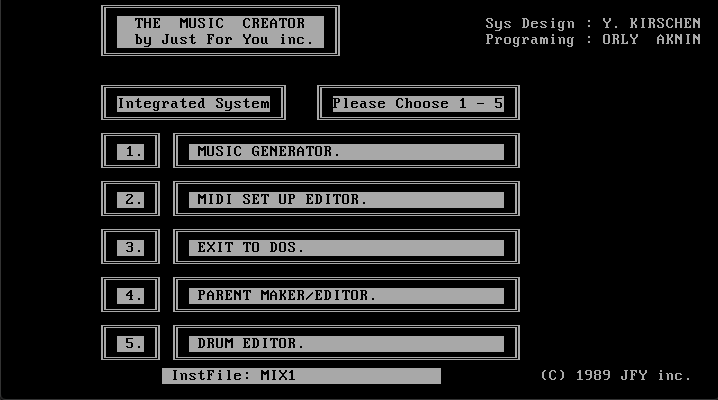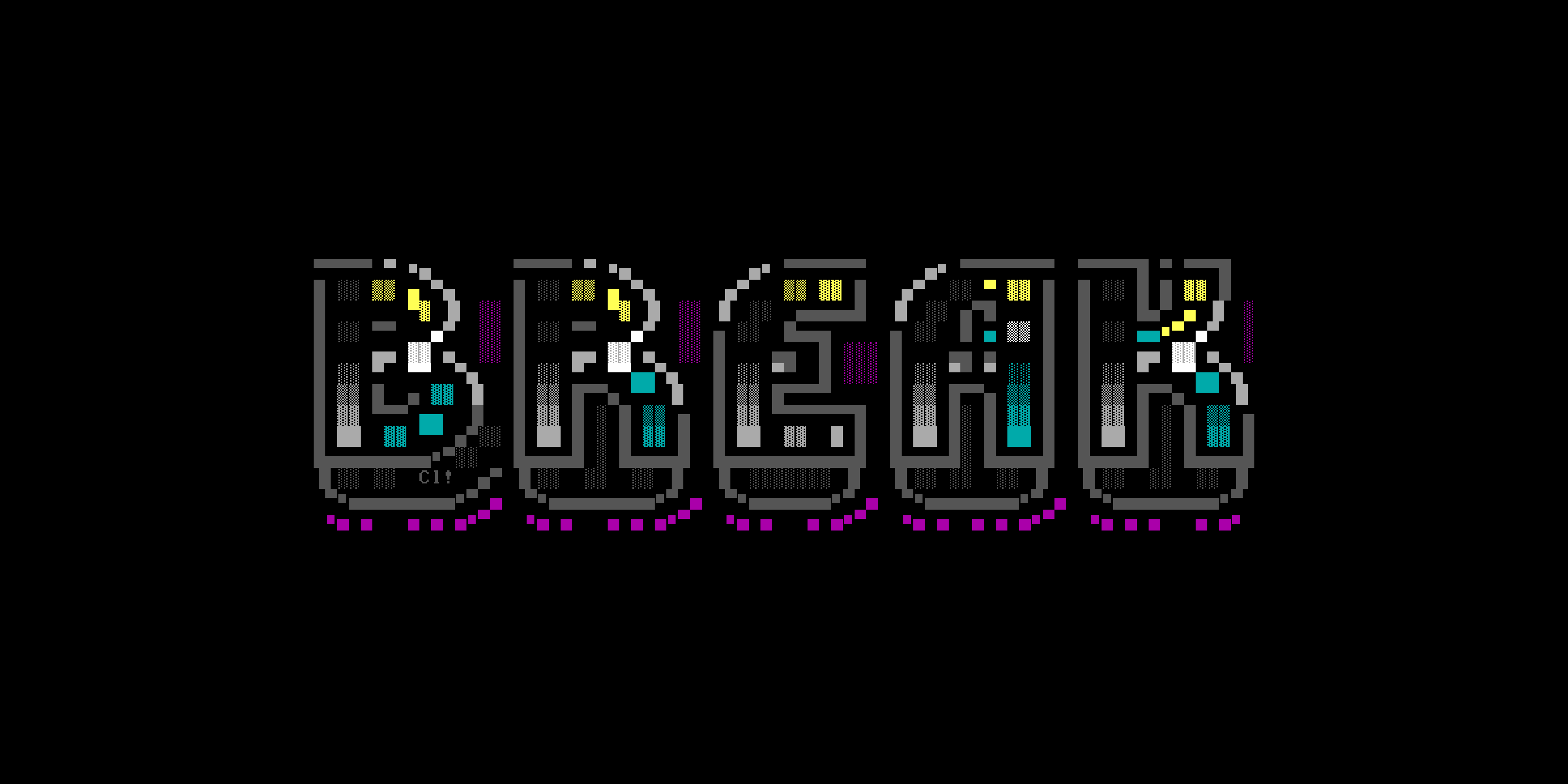
(Photo courtesy of Sali Ariel)
Decades before the debut of DALL-E, Israeli cartoonist Yaakov Kirschen was developing an “artificial creativity” system to let computers compose their own music, by extracting components of existing songs and combining them in new ways. The software was originally written for the Amiga, but business changes led them to abandon that platform and port the program to the PC. This blog post includes download links for the PC software.
- “The Music Creator” (Professional v1.3, 1989)
UPDATE (Jan. 2024): Some of the Amiga software has been recovered and can be downloaded here.
Keep reading for more background on Kirschen’s multi-year effort to find a market for his musical innovation, or skip down to the links to the Music Creator disk images.
This is one of five sets of curated disk images containing previously lost software developed by Kirschen. Additional Music Creator resources, including partial source code, will be released in the future.
This software was rescued from 5.25″ floppy disks, sent to Josh Renaud by Kirschen’s wife, Sali Ariel. The disks were imaged by Keith Hacke in 2020, then curated by Renaud.
Do you enjoy my retrocomputing stories on Break Into Chat? Please join my email list and stay in touch. 📬
Background
As his Atari ST computer greeting card project ran out of steam, Yaakov Kirschen began pursuing a new variation on his “just for you” idea.
This time, he toyed with ways to extract the “musical DNA” from popular songs and compositions. He wanted to develop software to let users recombine these components into new music tailored “just for you.” In contrast to the “Murray” and “Mom” software, which were examples of “artificial personality,” Kirschen described his new method for algorithmic composing as “artificial creativity.”
By this point, Kirschen’s relationship with Atari and its CEO Jack Tramiel had soured. So Kirschen pursued a partnership with Tramiel’s nemesis, Irving Gould at Commodore, intending to build his system around the Commodore Amiga 1000 computer and its superior sound chips, which could process digitized sound samples and play them in four-channel stereo.
Like Tramiel, Gould was familiar with Kirschen’s cartoons in the Jerusalem Post, and he seemed to relish the idea of working with Kirschen on something that Tramiel had dropped the ball on.
Kirschen began beefing up his staff of student programmers at LKP Ltd. He already had Yoram Biberman, who had joined LKP for the computer greeting card project. His first hire for the new Amiga project was Yuval Ronen. Over time, they were joined Marcelo Bilezker, Orly Aknin, and Dror Heller.

In 1986, Kirschen and Sali Ariel secured $160,000 in grant funding from the U.S.-Israel Binational Industrial Research and Development (BIRD) Foundation. Their “video computer music generator” proposal called for producing 6 to 10 themed music disks to sell to Amiga users at a retail price of $35. According to the grant proposal, Kirschen’s American firm, Just For You, Inc., had signed a deal with Commodore to bundle two of these themed disks, featuring pop (Beatles-esque) and baroque music respectively, with new Amiga systems for a royalty of $3 per Amiga sold. The proposal said Commodore was projecting sales of 200,000 Amigas in 1987.
By summer 1986, they had advanced far enough that Kirschen could show off the system. He presented a demo called “Jazzband” to the Jerusalem Rotary Club in June, then a more complete version of the consumer software under the name “Magic Harp” at summer computer shows in the U.S.
But LKP saw a repeat of its history with Atari. Amiga was a new platform with immature software tools and hardware problems. And LKP’s young programmers encountered many difficulties as they learned its ins and outs. They found it particularly challenging fitting the digital instrument sound samples, music database, and visual effects into the available memory.
And Commodore proved as unreliable a partner as Atari had been. Amid dire financial straits in 1986, the company changed strategy. They envisioned phasing out the Amiga 1000 in favor of two new models: the cheap mass-market Amiga 500, and the high-end, business-oriented Amiga 2000. The new machines arrived early in 1987, followed by further disruptions. Commodore closed the Amiga team’s Los Gatos office in March, then in April Gould fired (and replaced) Thomas Rattigan as CEO.
These changes killed the possibility of bundling Kirschen’s consumer “Magic Harp” software with the Amiga, according to LKP’s 1987 report to the BIRD Foundation. Commodore wouldn’t bundle any software at all with the low-end 500, nor would it consider bundling entertainment software with the business-oriented 2000. Kirschen’s deal with Commodore seems to have been dead by spring 1987.
The easiest path to profitability was closed. But Kirschen would not be deterred. They continued working on the software, including switching to the emerging MIDI standard instead of digitized sound samples. Kirschen felt sure there was still a market for his novel techniques, which by mid-1987 had at last been submitted to the U.S. Patent Office.
The end of the Commodore partnership forced LKP to fully pivot away from targeting consumers to marketing their software as a tool for professionals in the video post-production market. LKP had already taken steps in this direction, adding a “studio” module to the Magic Harp software to give users the option to fine-tune the music generation process.
LKP had extensive television and film connections through Ariel, who had worked as a producer for many years, and through Kirschen’s social network. They believed producers would embrace a turnkey system that could dynamically create background music, reducing or eliminating the need for costly music composers and performers.
By summer of 1987, the Amiga-based Magic Harp software and the pro-oriented composing programs were essentially complete. Kirschen hit the road, demonstrating his system at places like Lucasfilm and Video Tape Products.
After talking with Roland and others, it had become increasingly clear to Kirschen that the industry was moving to the IBM PC. Kirschen released all the student programmers except Orly Aknin, who was given the task of porting his software to the PC. Her work became “The Music Creator.”
Kirschen scored his biggest breakthrough in spring 1988, when he worked with editor Ron Frank to use his Amiga-based system to score “The Demjanjuk Dossier,” a 52-minute television documentary about the trial of John Demjanjuk for crimes he was alleged to have committed as a prison guard at the Treblinka killing center in German-occupied Poland. The BBC aired the documentary in primetime on June 15, 1988.

Several months later, Kirschen and his creation were profiled in-depth by the Los Angeles Times and the Associated Press. In both pieces he called his system the “JFY Post Production Music Generator” or “Jiffy Box.”
By this point, Kirschen and Ariel were increasingly desperate to find a partner and further financing. They connected with Alex Weiss, who had experience in hardware manufacturing from his work at Spectravideo in the early 1980s. Their plan was to sell the Jiffy Box as a “turn-key” system to the film and music industry.
They found almost no takers. Weiss ultimately made a deal with Port Barlow, founder of Computer Music Supply. Barlow was looking for music software to bundle with his CMS-401 device, an interface for connecting MIDI instruments to PCs. Kirschen’s “Music Creator” software fit the bill. Throughout 1989, CMS advertised these bundles in PC Magazine and other periodicals. “Music Creator Apprentice” was initially priced at $249, and the full bundle at $399.

Few copies seem to have been sold. A July 1989 discussion between two users on the rec.music.synth newsgroup gives a sense of their disappointment with aspects of the Music Creator Apprentice software. Barlow later told me that “Music Creator was a very short-lived product and wasn’t taken very seriously by musicians.”
Music Creator also appears to have found a German distributor, Magic Music of 7110 Ohrirrgen, and was reviewed in the March 1990 issue of the German DOS Magazine.
In terms of legacy, at least one important pioneer in algorithmic music composition took stock of Kirschen’s innovation. David Cope discussed Music Creator in his book “Computers and Musical Style,” noting it was one of the first commercially available programs “to deal explicitly with problems of musical style.”
“When successful, the program blends the music into new styles,” he wrote. “At its worst, Music Creator ‘composes’ nonsensical pastiches.”
Since then, Kirschen’s program also has been mentioned in several academic theses, though the references often derive from Cope’s book. The patent appears never to have been issued.
After their failure to find a market for their new techniques, Kirschen and Ariel were in deep financial trouble. They tried to use bankruptcy as a protection, but the bank just transferred the debt to them personally. “We even failed at bankruptcy,” Kirschen jokes today.
In the years afterward, Kirschen and Ariel made ends meet by designing television graphics on their Amiga for Israeli news stations, hotels and others. Kirschen has continued cartooning to this day, and has written a number of Jewish books. Ariel is an internationally-known oil painter.
The software
The Music Creator

Sali Ariel long believed the Amiga-based “Magic Harp” / “Jiffy Box” work was lost because she had thrown out all the 3.5″ floppy disks in her home years ago. But the PC-based “Music Creator” was saved on 5.25″ floppies, and these were sent to Josh Renaud. The TMC software and some source code was recovered by Keith Hacke from the disks. The source will be released in the future.
UPDATE (Jan. 2024): Ariel later found one package of 17 Amiga disks, and they are now archived. Learn more in this blog post.
When you run the TMC installer, it will ask about graphics cards and will install images in a PIC directory. But this version of TMC appears to use a text-only interface. Programmer Orly Aknin has confirmed to me that both graphical and text versions existed.
Disk images:
- tmc-install1.img (Installer disk 1)
- tmc-install2.img (Installer disk 2)
- tmc-install3.img (Installer disk 3)
- import-disk.img (Optional importer for add’l music data)
Note: The READ.ME file in import-disk.img contains the date July 8, 1989.
Credits shown in the program:
The Music Creator Professional v1.3
(c) 1989, JFY Inc.
Sys Design: Y. Kirschen
Programing: Orly Aknin

Share your thoughts!